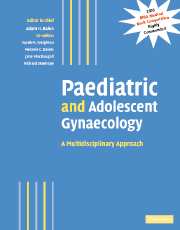Book contents
- Frontmatter
- Contents
- Contributors
- Preface
- Part I Normal development
- Part II Management of developmental abnormalities of the genital tract
- Part III Management of specific disorders
- 18 Disorders of growth and puberty
- 19 Turner's syndrome
- 20 Androgen insensitivity syndromes
- 21 Rokitansky syndrome and other Müllerian anomalies
- 22 The XY female
- 23 The gynaecology of the major genitourinary anomalies
- 24 Congenital adrenal hyperplasia
- 25 Long-term sequelae of genital surgery
- 26 Amenorrhoea
- 27 The polycystic ovary syndrome and adolescent women
- 28 Menstrual disorders in adolescent girls
- 29 Pelvic pain, ovarian cysts and endometriosis in adolescent girls
- 30 Premature ovarian failure and ovarian ageing
- 31 Gynaecological cancers in childhood
- 32 Late reproductive sequelae of treatment for childhood cancer
- 33 Preservation of fertility before cancer therapy
- 34 The management of infertility with surrogacy and egg donation
- 35 Dermatological conditions of the female genitalia
- 36 Vaginal discharge
- 37 Psychological gender development in individuals born with ambiguous genitalia
- 38 Eating disorders in adolescence
- 39 Nutritional amenorrhoea: long-term sequelae
- 40 How to set up a service: how to teach and train
- Index
- Plate section
- References
24 - Congenital adrenal hyperplasia
from Part III - Management of specific disorders
Published online by Cambridge University Press: 04 May 2010
- Frontmatter
- Contents
- Contributors
- Preface
- Part I Normal development
- Part II Management of developmental abnormalities of the genital tract
- Part III Management of specific disorders
- 18 Disorders of growth and puberty
- 19 Turner's syndrome
- 20 Androgen insensitivity syndromes
- 21 Rokitansky syndrome and other Müllerian anomalies
- 22 The XY female
- 23 The gynaecology of the major genitourinary anomalies
- 24 Congenital adrenal hyperplasia
- 25 Long-term sequelae of genital surgery
- 26 Amenorrhoea
- 27 The polycystic ovary syndrome and adolescent women
- 28 Menstrual disorders in adolescent girls
- 29 Pelvic pain, ovarian cysts and endometriosis in adolescent girls
- 30 Premature ovarian failure and ovarian ageing
- 31 Gynaecological cancers in childhood
- 32 Late reproductive sequelae of treatment for childhood cancer
- 33 Preservation of fertility before cancer therapy
- 34 The management of infertility with surrogacy and egg donation
- 35 Dermatological conditions of the female genitalia
- 36 Vaginal discharge
- 37 Psychological gender development in individuals born with ambiguous genitalia
- 38 Eating disorders in adolescence
- 39 Nutritional amenorrhoea: long-term sequelae
- 40 How to set up a service: how to teach and train
- Index
- Plate section
- References
Summary
Characteristics of congenital adrenal hyperplasia and medical treatment
Overview of the adrenal gland
The adrenal glands are triangular in shape, measuring 3 cm × 5 cm × 1 cm, and are sited above each kidney. The central adrenal medulla is responsible for production of adrenaline and noradrenaline. This portion of the adrenal may be dysplastic early in the natural history of congenital adrenal hyperplasia (CAH) and in time the hyperplastic cortex takes over and the medulla becomes atrophic (Merke et al., 2000a). Absence of the adrenal medulla is thought to be of no consequence because catecholamines are also produced throughout the nervous system.
The adrenal cortex is responsible for the production of three types of steroid; glucocorticoids (cortisol), mineralocorticoids (aldosterone) and androgens. CAH refers to defects in one of the enzyme steps in the adrenal steroidogenesis pathways, which mediate the alterations to the basic four carbon rings in the substrate cholesterol.
Cholesterol is the substrate for all steroid hormones (Miller, 1991). It is taken up by adrenal cells via receptors for low and high density lipoprotein (LDL and HDL, respectively), the abundance of which is increased by the action of adrenocorticotrophic hormone (ACTH). The scheme of adrenal steroid production is presented in Fig. 24.1. The conversion of cholesterol to cortisol occurs in five stages.
Cholesterol side-chain cleavage (cholesterol desmolase; gene designation: CYP11A1) is the rate-limiting step in the cortisol pathway. Cholesterol is delivered by StAR protein (steroidogenic acute regulatory protein) to the mitochondria where the side-chain cleavage enzyme is located. The electron transfer process, which results in removal of the side chain at C20, produces the cortisol precursor pregnenolone.
[…]
- Type
- Chapter
- Information
- Paediatric and Adolescent GynaecologyA Multidisciplinary Approach, pp. 310 - 326Publisher: Cambridge University PressPrint publication year: 2004
References
- 1
- Cited by



